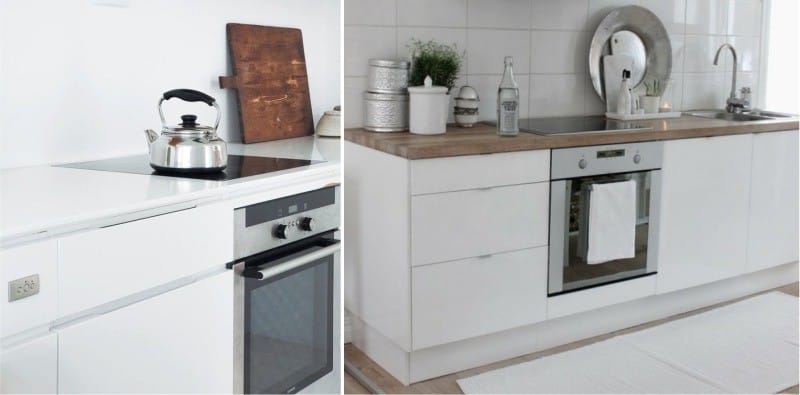Our own master – we install the oven
A kitchen cannot be imagined without a stove and oven. Today the stationary oven is being replaced by the modern built-in oven. The built-in type of equipment requires competent installation and connection in accordance with all the rules. It is worth starting with determining the location of its placement..
See also: How to choose an oven in 9 steps
The main types of oven designs. Place the technique correctly
The built-in oven can be:
- Dependent, that is, installed together with the hob;
- Independent, as a completely separate piece of equipment that you can install anywhere in the kitchen.
And the oven can be connected to an electrical or gas network.
Attention! If you can connect the oven to the electrical network yourself, then it is impossible to build in the gas oven without the involvement of specialists..
Do-it-yourself oven installation can be done in two ways:
- Traditional, when the oven was installed under the worktop. The top element of this design can be a hob..

- The built-in oven is installed separately from the hob, placing it above the worktop level. This makes it easy to follow the preparation of food, simplifies the maintenance of work surfaces, but in this case, you need a cabinet in which you can select a niche.
Regardless of where the oven will be installed, the niche must fit a certain size. Today, the dimensions of built-in appliances are standardized, you can find models (for example, an oven and a microwave) of the same size, which can harmoniously complement each other in one kitchen wall.

You can buy an oven and a kitchen module for it in the following sequence:
- First, design and order a kitchen set, and then choose an oven for the given dimensions of the future niche (all this can be done in the same salon);

- First, you can buy an oven, and then, when designing a kitchen wall, indicate the dimensions of the purchased model..
Furniture niche preparation rules
After the location and method of installation has been chosen, it is necessary to provide:
- Protection against voltage surges in the general electrical network;
- Grounding;
- Ventilation – you need to build in the oven at a distance of 50 mm from the rear wall of the niche, from the bottom 9-10 cm, and on the sides the gaps should be about 5 cm.

Installation in 4 steps
How to install a built-in electrical cabinet? The main thing here is to do everything clearly according to the manufacturer’s instructions and follow the safety rules..
Step. 1 Preparation: check the wiring. Basic requirements for the network to which the electric oven will be connected and installed:
- Sufficient level of resistance;
- High-quality wires, the cross-section of which corresponds to the declared power of the device;
- Ground wire and grounding system (standard requirements when connecting any household appliances at home);
- Circuit breaker, triggered in case of overloads or malfunctions of the device.
Advice! The magnitude of the current that ensures the operation of the machine is selected individually. This is influenced by the electrical power of the particular model selected..

To connect the built-in oven in accordance with all safety requirements, you must use a powerful copper wire (indeed, it is better to create a separate branch of the wiring). Since the oven consumes a lot of electricity, you will also need special sockets designed for the power indicated in the technical data sheet..
The rest of the safety rules are as follows:
- The connection of wires on twisting is not allowed.
- Recovers a direct connection of wires made of different materials – aluminum and copper.
- To connect the wires, it is imperative to use screw terminals.
- Connection to the electrical panel must go through a separate machine.
Step 2. Next, the built-in oven is placed in a special pre-prepared niche. If the niche has a back wall, then you need to make a hole in it for wires.

Step 3. Then the oven is inserted into place and securely fixed with the screws (included in the kit) with a screwdriver or Phillips screwdriver.

Step 4. It remains only to wash all the inner surfaces of the oven, then bake it at a maximum temperature (150 – 250 C) for 30 minutes and, after cooling, wipe it with a damp cloth. The oven is ready to use!
Gas oven
The built-in oven may well be gas. However, such a connection to the network can only be carried out by specialists of the gas service – all these nuances are carefully controlled by them..
Advice! Before connecting the oven, the gas supply to the apartment is shut off. Therefore, it is more profitable to install the hob immediately.
The connection process consists in connecting the oven to a pipe that supplies gas to the kitchen through special gas hoses, while the gas source should be located at a distance of up to 1.2 m from the oven.
Before the final switching on of the equipment, the gas must be checked for switching on – as soon as a characteristic smell appears, the gas supply is shut off again until the malfunctions are eliminated. Upon completion of the work, the equipment is connected to the electrical network (ignition and lighting work from electricity).
